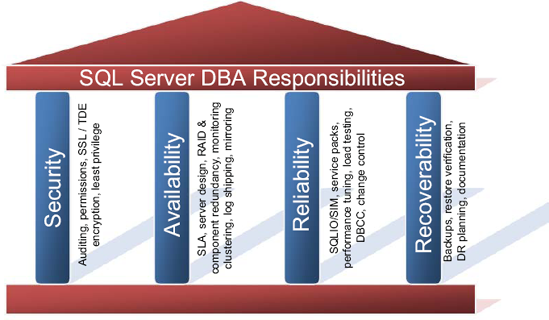1.4. DBA responsibilities
Most technology-focused IT professionals can be categorized as either developers or administrators. In contrast, categorizing a DBA is not as straightforward. In addition to administrative proficiency and product knowledge, successful DBAs must have a good understanding of both hardware design and application development. Further, given the number of organizational units that interface with the database group, good communication skills are essential. For these reasons, the role of a DBA is both challenging and diverse (and occasionally rewarding!).
Together with database components such as stored procedures, the integration of the CLR inside the database engine has blurred the lines between the database and the applications that access it. As such, in addition to what I call the production DBA, the development DBA is someone who specializes in database design, stored procedure development, and data migration using tools such as SQL Server Integration Services (SSIS). In contrast, the production DBA tends to focus more on day-to-day administration tasks, such as backups, integrity checks, and index maintenance. In between these two roles are a large number of common areas, such as index and security design.
For the most part, this book concentrates on the production DBA role. Broadly speaking, the typical responsibilities of this role can be categorized into four areas, or pillars, as shown in figure 1.3. This book will concentrate on best practices that fit into these categories.
Let's briefly cover each one of these equally important areas:
Security—Securing an organization's systems and data is crucial, and in chapter 6 we'll cover a number of areas, including implementing least privilege, choosing an authentication mode, TCP port security, and SQL Server 2008's TDE and SQL Audit.
Availability—Ensuring a database is available when required is a fundamental DBA responsibility, and in this regard, SQL Server 2008 includes a number of high-availability solutions, including failover clustering, database mirroring, and transaction log shipping, each of which we'll cover in this book. We'll also examine the importance of service level agreements in a high-availability plan, and learn how to design redundancy into server components.
Reliability—Unexpected performance and corruption problems not only disappoint users, but they also lead to long, chaotic, and reactive working days for a DBA. Throughout this book, we'll cover a number of proactive maintenance and design practices, such as using the SQLIOSIM utility to validate a storage system, and using Database Console Commands (DBCC) to validate the integrity of a database.
Recoverability—Of course, should disaster strike, a DBA needs to spring into action with a plan of attack for restoring a database as quickly as possible, and in chapter 10, we'll cover this process in detail.
Ensuring databases are secure, available, reliable, and recoverable are core DBA responsibilities. In subsequent chapters, we'll drill down into each of these responsibilities in more detail, beginning with the next chapter, in which we focus on the important topic of sizing a storage system.

